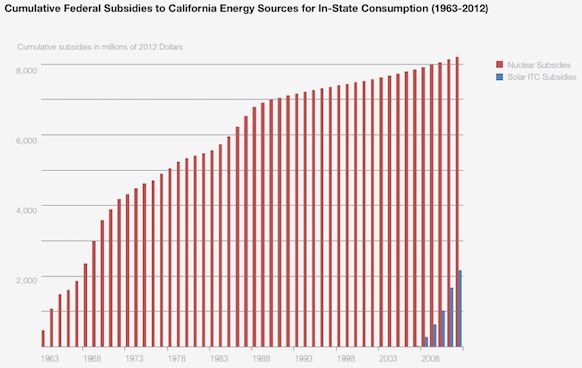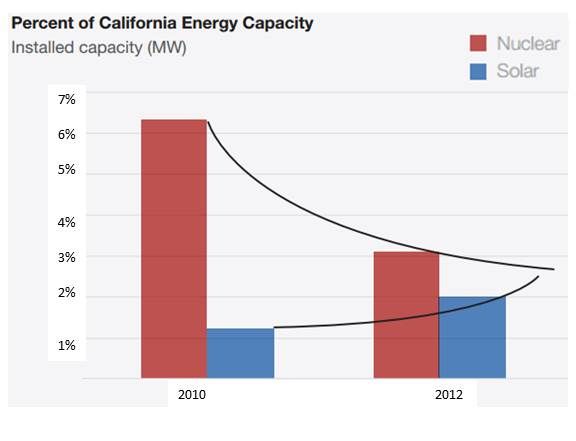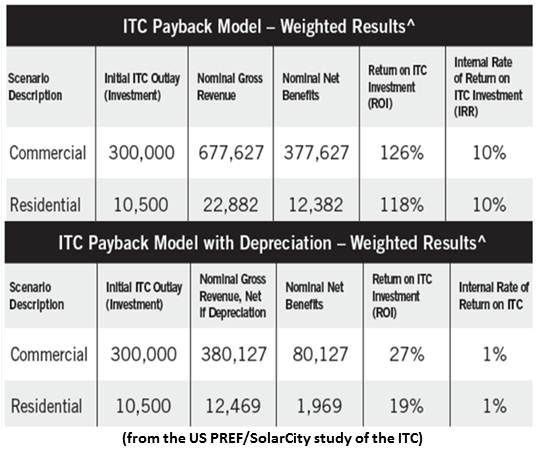California’s nuclear energy industry has received four times more federal support than the state’s distributed solar builders over a period six times as long, according to a new report.
“California’s nuclear power suppliers have benefited from over $8.21 billion (in 2012 dollars) in subsidization over the last half century,” according to the report Ask Saint Onofrio: Finding What Has Been Lost in a Tale of Two Energy Sources by Nancy E. Pfund and Noah W. Walker of Silicon Valley venture capital firm DBL Investors.
Distributed solar systems, they found, have earned $2.17 billion in tax credits or direct payments through 2012 from the federal investment tax credit (ITC) and the 1603 Treasury Grant programs, which began in 2007.
The 56-year-old Price-Anderson Act’s liability protection for nuclear plant operators and tax breaks for the decommissioning trust fund earnings together account for an estimated $164.1 million in annual federal support.
The legislators who passed the Price-Anderson Act expected it to sunset after ten years, yet it is authorized through 2020, Pfund, DBL’s Managing Partner, observed. “Federal subsidies were necessary and highly effective for the early growth of the nuclear industry,” she explained. But they have become “a perpetuity.”
Meanwhile, Congress is expected to allow the ITC to fall to 10 percent in 2016, and utilities from California to Vermont are fighting their states’ net metering programs.

Source: DBL Investors
The return on taxpayers’ investments are starkly different, the report noted. The 2,200-megawatt San Onofre Nuclear Generating Station failed in 2011 and was permanently taken offline this year. Attempted repairs have cost ratepayers $670 million, and a further $4.1 billion will be passed on to them for decommissioning.
Meanwhile, the ITC last year was “crucial” in engendering California’s 1,000-plus megawatts of new distributed and utility-scale solar and the 11,000 new jobs that growth supported.
“The ratio of federal subsidies per megawatt-hour of generation for nuclear has declined precipitously,” the report acknowledged. But federal support for nuclear energy cost taxpayers over $600 per megawatt-hour in 1963, one of the earliest years in which nuclear was subsidized. “This ratio has declined as nuclear has matured; we anticipate a similar decline for solar,” the report added. Already, it found, federal dollars per new megawatt-hour of distributed solar capacity is “infinitely lower than for nuclear.”
“No policy professor would recommend giving money, decade after decade, to an energy source that has a lot of problems and is declining in importance and, at the same time, cutting off support to a new clean energy source that is growing. What makes sense is to predictably phase the ITC out more gradually.”

The DBL report focused on California. The day after its release, Entergy (ETR), the second biggest U.S. nuclear plant operator, announced it would permanently close its troubled Vermont Yankee nuclear facility. That followed other recent evidence the nuclear industry’s federal subsidies do not return value to taxpayers, including:
- The Duke (DUK) cancellation of its Levy reactor project in Florida
- The announcement by EDF, France’s nuclear giant, that it will leave the U.S. nuclear market
- Shutdowns of the Kewaunee nuclear facility in Wisconsin and the Crystal River nuclear facility in Florida
- The cancellation of two planned reactor expansions at LaSalle in Illinois, two at Limerick in Pennsylvania, and one at Prairie Island in Minnesota
“With little chance that the cost of new reactors will become competitive with low-carbon alternatives in the time rame relevant for old reactor retirement decisions,” noted Vermont Law School Institute for Energy and the Environment nuclear expert Mark Cooper, "we need to start preparing now for more early retirements."
“The pace of change is accelerating in electric power markets, and the challenge facing U.S. nuclear power stakeholders is whether or not they can adapt fast enough over the next 50 years to remain relevant to future electric market needs,” noted the DOE-funded Assessment of the Nuclear Power Industry, conducted by Navigant Research for utility industry groups and released the day of the Entergy announcement.
“When the government first promoted nuclear power,” Navigant observed, “it held promise to be a disruptive technology, but its capital-intensive nature and unknown operational requirements caused most utilities to adopt a ‘wait and see’ attitude.”
Federal support through the Atomic Energy Commission got reactors built and allowed the industry to mature. “Their patience was rewarded in the latter half of the 1960s when orders for new plants rapidly increased.”
After a half century of federal subsidies, Navigant observed, the safe disposal of nuclear waste remains an unsolved obstacle to growth in the U.S. that will require $20 billion in federal support for the industry through 2020. And the nuclear industry has become increasingly controversial internationally in the wake of the Fukushima disaster. The Japanese public is resisting it, and “Germany, Italy, Sweden, Belgium, Austria, and Switzerland have all passed laws phasing out nuclear power.”
Yet in California and elsewhere, utilities have not acknowledged they have been the beneficiaries of huge government support that has reduced their risk and their cost of capital. Pfund observed, “They call the net metering programs that support solar, a new source that consumers want and is getting cheaper every day, a cost shift instead of a revenue reduction.”



